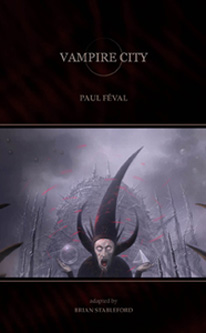“There is a little-known place which is undoubtedly the strangest in the world. The people who inhabit the barbarous lands around Belgrade sometimes call it Selene, sometimes Vampire City, but the vampires refer to it among themselves by the names of the Sepulcher and the College.”
Paul Féval’s Vampire City is one of those terrible books that unfolds like a train wreck, but you can’t put it down because it’s extremely entertaining and more than a little bit insane. When Féval pulls the lid off his id he concocts some of the most wild and vividly imagined pieces of “weird” pulp fiction you’re likely to encounter.
The plot has Ann Radcliffe (yes, that one) trying to save her friend Cornelia from the attentions of the vampire Otto Goetzi. Assisted by her manservant Grey Jack, her friend Ned (Cornelia’s fiance), his manservant Merry Bones (an Irish “nailhead”), and a captured transgender vampire named Polly (who is chained to an iron coffin she carries on her shoulder), Ann sets off for Selene, the Vampire City, like a proto-Buffy the Vampire Slayer.
Written in 1867, three decades before Dracula, Vampire City is the second of Féval’s three vampire novels (Knightshade and The Vampire Countess being the other two). Féval’s vampires don’t resemble Stoker’s creation in more than slight details. According to Brian Stableford in the book’s afterword, both authors made use of the same 18th century text, Dissertations sur les Apparitions des Esprits, et sur les Vampires by the biblical scholar Dom Augustin Calmet (what, you don’t own a copy?), adding to this source elements from their own nightmares.
In Féval’s case this meant doppelgangers (his vampires can duplicate themselves), leeches (his vampires don’t have fangs but puncture the necks of their victims with a barb-like tongue and then suckle at the wound), hair theft (Féval had an eyebrow-raising thing for hair and bald women, and his vampires steal the hair of their victims), and the Vampire City itself, Selene, where the vampires return when they are in peril. Not stopping there, Féval reveals that his vampires are clockwork flesh-and-blood automatons, who require winding by an “evil priest” in order to heal themselves. (Sadly, this “evil priest” never shows up in the novel.) Oh, and Féval’s vampires explode when they come into contact with another vampire’s cremated heart. Fun stuff!
Black Coat Press (and Brian Stableford) should be applauded for making Féval’s novels (among many others) available for English language audiences. While possibly only a curious tangential ancestor to contemporary vampire fiction, Vampire City might best be seen as the precursor of New Weird works such as the New Crobuzon novels of China Miéville. Both authors use formulaic genre conventions with an audacity that startles readers and intrigues them with odd, even horrific, concepts. Like Miéville, Féval succeeds in haunting the reader with weird imagery alone. A gift that more than makes up for the lack of logic one encounters in the novel.
Justin Howe’s short fiction has appeared in Fast Ships, Black Sails; Beneath Ceaseless Skies; and Brain Harvest. For those who would like to read more about the weird world of French pulps, check out his article “Who? Fantômas!” in the Internet Review of Science Fiction.










